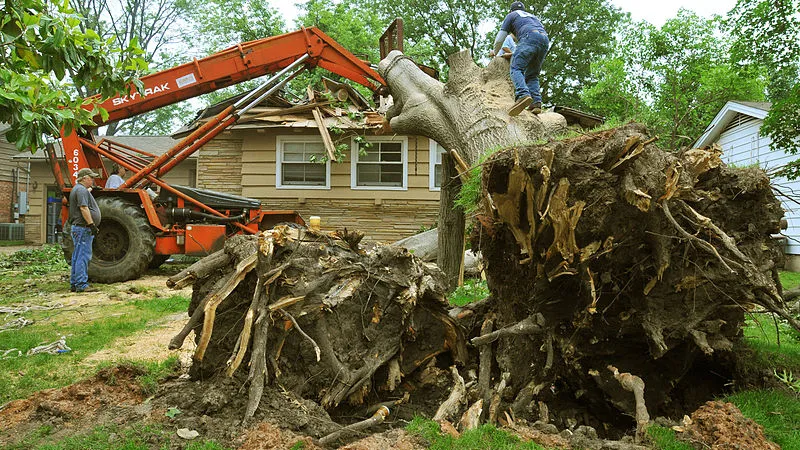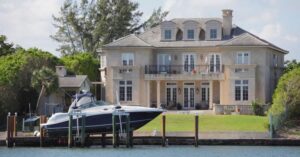In general, healthy, well-maintained trees can raise the value of your home in addition to beautifying it. A falling tree or large branch, on the other hand, can cause property damage, personal injury, or, at the very least, a mess that no one wants to deal with. So, who is accountable for the cost of everything once a tree falls? Who is responsible if a tree falls and causes property damage or personal injury? Is it necessary for you or your neighbor to have a fallen tree removed?
The short answer is that you are responsible for the removal of any fallen tree when it’s from your property. If you have homeowners insurance, however, the clean-up of the tree and any damage charges are likely to be covered.
On the other hand, if the tree has fallen onto your neighbor’s land, the same rules apply as before, but if it has fallen over your common fence, from your neighbor’s end, then they are accountable.
Meanwhile, the city will usually pay for the cleanup and repairs if a tree falls from a public space onto your property and causes damage.
Well, let’s go into this in detail and basically every piece of information you should know about who will be responsible for fallen tree removal.
Who is Responsible for a Fallen Tree Removal? Insurance for Homeowners
The following are the two most important considerations in determining whether your homeowner’s insurance will cover the costs of a fallen tree:
First and foremost, it starts with the cause of the tree’s fall and the circumstances surrounding it. You basically need to ask the question; How thorough is your coverage?
In most cases, your homeowners’ insurance policy would cover your primary residence, as well as your shed, fence, and other structures on your property. So, if a tree falls due to strong winds, storms, or other natural forces and damaged parts of your property, your insurance policy is likely to cover the expenses of repair. However, depending on the terms and conditions of your insurance policy, you may be responsible for the deductible.
Homeowners’ insurance plans, on the other hand, are unlikely to cover fallen trees caused by your negligence, such as a lack of care and upkeep. For example, if a tree has been dead for many years and falls due to no external forces such as strong winds or storms, your insurance policy is unlikely to cover the losses. Similarly, if a branch was removed by an inexperienced worker and the tree fell, your insurer is unlikely to compensate for the losses.
Will My Homeowners Insurance Cover Trees That Have Fallen?
While it is ultimately up to the insurance company’s judgment, there are a few criteria that can influence whether your homeowner’s insurance will cover the costs of a tree falling on your property:
For starters, yes, your homeowner’s insurance will likely cover the expense of removal and damage if the tree fell due to natural causes. If a tree on your property or on your neighbor’s property falls due to natural reasons and damages a shared fence, your homeowner’s insurance will normally cover half of the cost, with your neighbor’s insurance covering the other half.
Your homeowner’s insurance will likely not cover any costs related to clean-up, removal, or repairs if the tree fell due to negligence, such as a lack of care and upkeep.
What if My Tree Falls on the Property of My Neighbors?
The reason for the tree’s fall is once again a factor. If the fall is caused by natural factors such as strong winds or a storm, your neighbor’s homeowners’ insurance policy will pay the costs.
Both you and your neighbor are responsible for half of the expense if the tree damages the fence. As a result, your neighbor’s insurer may only cover 50% of the fence’s cost, leaving you to seek the remaining 50% from your own insurer. However, there are instances where you may be held liable if a tree falls on your neighbors’ land.
Here are several scenarios in which you may be held accountable for damages and receive an olive branch from your insurance company:
- Negligence or lack of upkeep caused the tree to fall. For example, the tree was rotting and you failed to take prompt measures to safely remove it.
- Because the tree is of a species that is noted for losing branches, you should expect to have those branches removed quickly.
- The tree fell during a removal where you chose to do it yourself or hire someone without a license rather than engage a professional arborist.
- The tree removal firm you hired did not have the proper equipment to prevent falls and did not have public liability insurance.
In such cases, you may be responsible for the damages because your insurer is unlikely to come to your aid.
Who Is Responsible if a Tree From a Public Park Falls on My House?
If you live near a public park, a tree may fall on your home during a storm or strong winds. And as you already know, the first thought that comes to mind is who is responsible for the damages and how much it will cost to remove the tree.
Basically, you are usually one of the tree’s owners because the tree belongs to the community. As a result, your homeowners’ insurance policy would cover all of the losses caused by the fallen tree, including damage to your primary property, your fence, and any other structures in your yard.
But, the local town committee or any other local body responsible for managing the trees in public spaces of your town or committee will be responsible for the costs of tree removal.
Who Is Liable if a Tree From Your Neighbor Falls on Your Home?
This question’s solution is identical to the one we gave in the previous question about a tree from your property falling on your neighbor’s.
Your homeowners’ insurance policy would cover the cost of repairs if the fallen tree caused structural damage to your home. The expense of debris clearance may also be compensated in this case. In terms of the cost of fixing the fence, the expenses would have to be shared between both parties, as is customary, and your neighbor would have to rely on their homeowners’ insurance coverage to cover the costs.
Your homeowners’ insurance coverage may not cover the expense of tree removal in this case. In such cases, your neighbor is responsible for tree removal costs. You’ll need to inform your neighbor that tree removal isn’t covered by your insurance policy and ask them to take the appropriate steps.
Your Neighbor’s Tree Is Dead and Dangerously Close to Your Property Line; What’s Next?
In this case, the best thing to do is establish contact with your neighbor. Inform him or her that their tree is dead and inquire about having it removed. Offering to split the expense of a tree examination and/or removal if your budget allows it may make this conversation go more smoothly.
Most people will appreciate the heads-up, but if the conversation doesn’t go as planned (or if your neighbor refuses to have the tree evaluated or removed), you may need to try another approach.
Documentation is essential in any situation involving the prospect of insurance claims or legal action. Write your neighbor a note expressing your concerns about the tree. Clearly ask that the tree be removed, and state that if the tree falls and destroys your property, you will pursue legal action.
Send the letter to your neighbor via the US Postal Service, and for your own safety. Also, send it certified with a return receipt so that you have proof that the letter was received. Make two copies of the letter, one to send to your insurer and one to maintain for your records.
Is this how you make friends with your neighbors for life? Most likely not. However, your home is one of the most important investments you’ll ever make, and you must safeguard it.
Is it Possible for Me to Remove a Fallen Tree?
No. If you don’t have the right training and experience, tree removal is one of the most dangerous chores you can do. While a do-it-yourself approach may be appealing, tree removal is a difficult task that involves extensive training, specialized equipment, and proper licenses.
You will be held personally liable for any damage or harm caused by the removal, transportation, or disposal of a tree if you do it yourself or employ someone without the required licensing instead of a professional arborist.
If you’re in charge of removing a fallen tree, don’t try to do it yourself—always seek expert assistance.
This is because chainsaws and other power tools can be highly dangerous to handle, especially if you’re a beginner, and especially after a severe storm when surfaces are likely still slick with water or ice.
On the other hand, even if the utility has turned off the electricity, never try to untangle limbs from a power line. A generator that is improperly installed or damaged has the potential to back-feed power onto the grid, resulting in electrocution.
Partially fallen trees are also hazardous since they are frequently supported by limbs that can collapse and fall again if disturbed.
Meanwhile, because there is a considerable chance of on-site harm when soliciting hazardous work like tree removal, it is critical that the removal business has workers’ compensation insurance.
Precaution: Consult a Professional Arborist Before Chopping Down a Fallen Tree With a Chainsaw

You are responsible for inspecting the trees on your property; take the time now to evaluate them for visible damage, and then hire an arborist to provide an expert assessment.
An arborist can assess the health of your trees and identify any potential risks. As earlier mentioned, you can have a tree on an adjacent property assessed and then legally alert the tree owner of its unsafe state if you’re concerned about it. This assessment will provide you with more evidence of the tree owner’s negligence if the tree does fall on your property.
Arborists are employed by several tree service companies. However, you’d need to ask about the company’s credentials—arborists are certified by the International Society of Arboriculture, while businesses can join the Tree Care Industry Association. These affiliations and certificates show that the company and its personnel are up to date on current safety measures and tree health guidelines.
Also, working with a trained business to take safeguards now will ensure a safer environment for your home, family, and neighbors.
Fallen tree removal can be really expensive, especially if it damages property in its path.
In Conclusion (Who is Responsible for a Fallen Tree Removal)
Trees are a beautiful element of the environment, but they can also be a big source of irritation. And because trees can cause so much harm when they fall, keeping a watch on your own trees as well as those in your neighbors’ yards is crucial to keeping your home secure and free of storm damage.
We already know that it isn’t at all entertaining to argue with your neighbor about who is to blame for a fallen tree. But then it’s one of those aspects of homeownership that practically everyone goes through at some point. The following are some key considerations:
- File a claim with your home insurance carrier if a tree falls on your property or your property is harmed.
- If a tree falls on your neighbor’s property or their home is destroyed, their homeowner’s insurance will cover the cleanup and repairs.
- Your neighbor may take legal action against you if you knew a tree on your property was damaged and in danger of collapsing but did not have it removed.
- You can also take legal action if your neighbor was aware of a dead or dying tree and did nothing to remove it.


